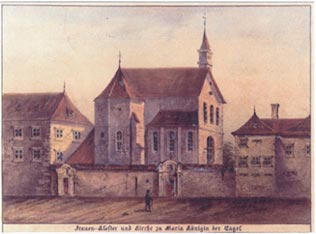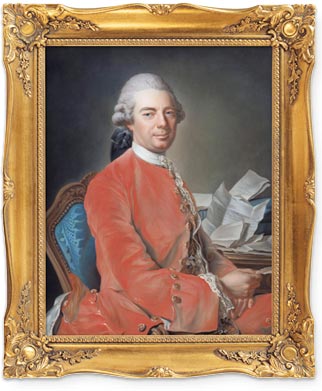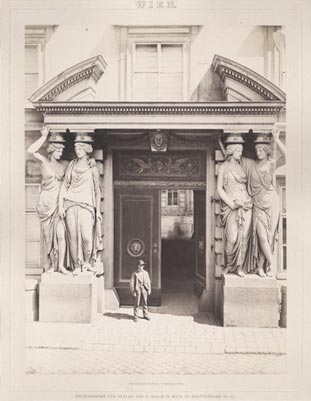HISTORY AND ARCHITECTURE

Queen's Monastery
founded in 1581 by Elisabeth of Austria

Count Johann von Fries
(1719 – 1785) built today's Palais Pallavicini
on the grounds of the “Queen’s Monastery”
after it was disbanded and partitioned in 1782.

Palais Pallavicini
with caryatids by Franz Zauner framing the front entrance, photo taken around 1890
Located in the heart of Vienna, the Palais Pallavicini forms an architectural ensemble with the Hofburg Imperial Palace and the Spanish Riding School.
The Palais Pallavicini is the result of a variety of reconstruction and remodeling work done on a former convent location, called “Queen’s Monastery” or “Convent of Poor Clares Mary, Queen of Angels” founded in 1581 by Elisabeth, widow of King Charles IX of France and daughter of Maximilian II. The building’s foundation was laid in 1582. The monastery hence was closed on 12 Jan.1782 under Emperor Joseph II and then split into various building sections.
Count Johann von Fries acquired one of these sections commissioning Ferdinand Hohenberg von Hetzendorf, the architect of Vienna’s famous Gloriette, with its reconstruction.He erected one of the most interesting palace buildings in Vienna with a facade where the rich High Baroque style gives way to the simpler features of classicism for the first time.
The powerful lines of the building are animated by the entrance and the parapet. The caryatids perfectly combine grandeur with grace and, like the female figures on the parapet, are the work of Franz Zauner, who is also responsible for the famous statue of Emperor Joseph, located in the square facing the palace.
What we now view as an exciting transition between two architectural styles caused considerable scandal in its day. Directly facing the Hofburg, the stark simplicity of its facade was highly controversial and the ‘baroqueification’ of the facade was a necessary architectural concession to the baroque magnificence of the surrounding buildings.
The staircase, with its beautiful classical latticework leads to the magnificent state rooms on the second floor. These rooms boast splendid stuccowork on their walls and ceilings, especially in the magnificent ballroom where a love of sumptuous detail and stunning mirror effects can still be seen on its ancient baroque walls. The impressive ornate chandeliers and candelabra are preserved to this day.
The state rooms have always been a place of festive and cultural activities; Imperial Count Moritz von Fries, the son of the man who built the place,was one of the richest men of his time. Legend has it that Moritz served as inspiration for Ferdinand Raimund’s play “The Spendthrift”;his palace picture gallery held some 300 masterpieces of European painting and more than 100,000 engravings; the library contained around 16,000 books. The Count promoted and supported musical activity as well – Ludwig van Beethoven and Franz Schubert were frequent guests at the Palais. Ultimately, an economic crisis destroyed Mortiz' fortune, forcing him to sell the palace.
Finally, in 1842 Alfons Pallavicini acquired the palace; in 1873 it was inherited by his son Alexander Pallavicini senior. Alexander remodeled the staircase and state rooms along the historical lines seen today. Fortunately, the palace did not suffer any serious damage during the two World Wars and can therefore still be admired in its original state to date.
